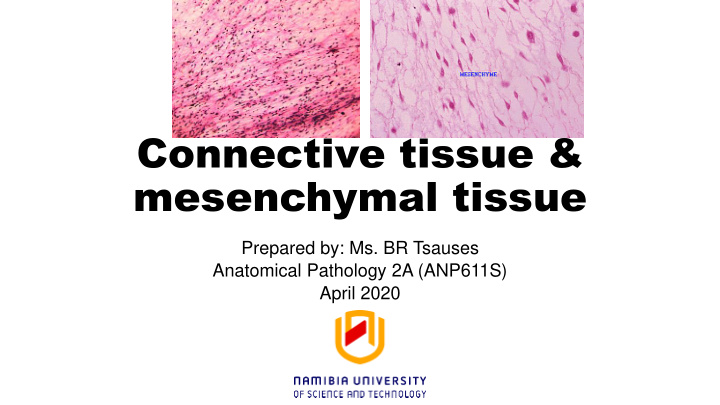



Connective tissue & mesenchymal tissue Prepared by: Ms. BR Tsauses Anatomical Pathology 2A (ANP611S) April 2020
Learning objectives • Understand connective and mesenchymal tissues in order to describe and apply appropriate staining techniques in Histology.
Pre-learning Quiz • Please take the pre-learning quiz before proceeding with the presentation.
Introduction • Connective tissue (CT) is of the four tissue types • Derived fom latin word connectere meaning to bind. • Is to connect together and provide support
Introduction cont … • During embryonic development: ectoderm + endoderm = mesoderm • This germ layer is known as mesenchymal • Mesos means middle • Enchyma means infusion
Connective tissue CT are divided into: 1. Connective tissue proper (dense, areolar, regular,adipose regular and reticular 2. Cartilage (hyaline elastic, fibrocartilage) 3. Bone( spongy or cancellous and dense or cortical) 4. Blood 5. Blood-forming (hematopoietic)
Connective tissue cell types • Fibroblast • Mast cells • Histocytes • Adipose cells • Reticulor cells • Osteoblast and osteocytes • Chondroblast and chondrocytes • Blood cells and blood forming cells
Intercellular substance • Intercellular substance (ICS) is composed of both amorphous(sulfated and non sulfated mucopolysaccharides) and formed elements (collagen, reticular fibers and elastic fibers) • The nature of these substance varies according its function (hard or dense or soft.) • Classified into: formed or fibrous type : gel or amorphous type
Formed or fibrous intercellular substances Collagenenic fibers • Most common ICS found in large quantities in most sites • Appear as individual fibers as in loose areolar tissues e. g tendon • Collagenic fibers do not branch • Collagen types: Type (i) up to (vi)
Reticular fibers • Provide bulk of supporting network of more cellular organs e. g spleen, lymph nodes, liver. • To support individual cell within the tissue.
Elastic fibers • Elastic fibers are associated with respiratory system, circulatory system and integumentary system • Oxytalan fibers • Elaunin fibers • Lack structure or functional significance.
Basement membrane • Found throughout the body as resilient matrix separating connective tissue from epithelial • Support epithelial cells • Support epithelial cells lining blood vessels etc • Divided into three zones or layers: - lamina- rara (or lamina lucida) - lamina densa (basal lamina) - lamina reticularis
Connective tissue
Connective Tissue cont.
Connective tissue cont (examples)…
Connective tissue cont …
Connective tissue…
References 1. John D. Bancroft, Christopher Layton and S.Kim Suvarna, (2013),Bancroft’s Theory and Practice of Histological Techniques,7thEdition, Elsevier, China 2. J.A.Kiernan,(2015)Histological and Histochemical Methods, 5thEdition, Scion, UK
Recommend
More recommend